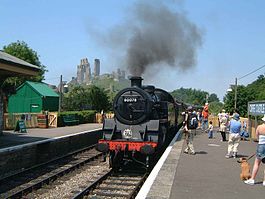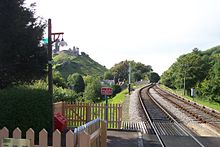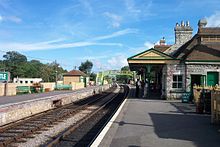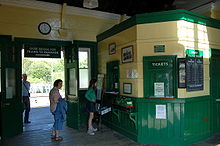- Corfe Castle railway station
-
Corfe Castle 
Steam loco 80078 pulls into Corfe Castle station. The castle is visible in the background. Location Place Corfe Castle Area Purbeck Coordinates 50°38′18″N 2°03′18″W / 50.6383°N 2.0551°WCoordinates: 50°38′18″N 2°03′18″W / 50.6383°N 2.0551°W Operations Original company Swanage Railway Platforms 2 History 20 May 1885 Opened 3 January 1972 Closed 12 August 1995 Reopened Stations on heritage railways in the United Kingdom A B C D E F G H I J K L M N O P Q R S T U V W X Y Z Corfe Castle railway station is a railway station located in the village of Corfe Castle, in the English county of Dorset. Originally an intermediate station on the London and South Western Railway (L&SWR) branch line from Wareham to Swanage, the line and station were closed by British Rail in 1972. It has since reopened as a station on the Swanage Railway, a heritage railway that currently runs from Norden station just north of Corfe Castle to Swanage station.
Contents
History
Corfe Castle lies in the centre of the Isle of Purbeck, a peninsula bordered by the English Channel to the south, and by the marshy lands of the River Frome and Poole Harbour to the north and east. At the beginning of the 19th century, the area around Corfe Castle was known for its supply of Purbeck Ball Clay, which at that time was shipped by a pair of horse drawn tramways (the Middlebere Plateway and the Furzebrook Railway) to wharves on Poole Harbour. The port of Swanage at the tip of the Isle was equally well known for the Purbeck Marble that was mined locally and shipped out by sea.[1]
The presence of these industries attracted railway promoters once the L&SWR main line reached Wareham in 1847. Several schemes were promoted and failed, but eventually the Swanage Railway received its Act in 1881 and opened on 20 May 1885. The position of Corfe Castle, commanding the only relatively low level route across the hilly spine of the Isle of Purbeck, meant that line passed close to the centre of the village, and Corfe Castle station was built for the opening of the line. From its opening, the line was operated by the L&SWR, and line was absorbed into that railway in 1886. Corfe Castle station was the only intermediate station on the Swanage branch, a status it retained until closure by British Rail, and possessed the only passing loop between the junction with the main line at Worgret Junction and Swanage.[1] In 1960, the station was allocated a camping coach converted from a Pullman car, which was fitted with a full kitchen, two sleeping compartments and a room with two single beds.[2]
While the development of Swanage as a tourist resort brought significant passenger traffic to the line, the collapse of both the clay and marble industries, and the increase in private car ownership in the second half of the 20th century made the line unprofitable. Closure was first proposed in 1967, and despite local opposition the line finally closed on 3 January 1972.[3]
From the time of the first proposal of closure, a strong campaign to reopen the railway as a steam locomotive operated heritage railway developed. Most of the track bed, including Corfe Castle station, was bought by Dorset County Council. Proposals to use the railway route through the Corfe Castle gap as a road bypass for the village were eventually rejected by the county council in 1986. In the meantime the Swanage Railway had started operating a steam service at the Swanage end of the line in 1982.[4]
There were concerns that reopening Corfe Castle station as a northern terminus for the Swanage Railway would make existing parking problems in the picturesque village. It was therefore decided to extend the line a further half a mile north to a new Park and Ride site built on the former location of the exchange sidings between the Swanage branch and the clay tramways. Here the new Norden station was built and most trains terminate here. Corfe Castle station reopened on 12 August 1995, although the official opening was not until February of the following year.[4]
A 5 year project by Swanage Railway volunteers to install a footbridge across the running lines between the platforms at Corfe Castle was completed in April, 2007, when David Quarmby, CBE, carried out the official opening. The footbridge was originally built in 1893 by the London, Brighton and South Coast Railway. With cast iron columns and a wrought iron span, the footbridge spent its life at Merton Park in London, near Wimbledon, on the West Croydon line until removed by Swanage Railway volunteers. The footbridge can accommodate the large numbers of people who now use Corfe Castle station, and is important because it is much safer and more convenient for the public than crossing over the track via the gated and locked foot crossing. The project won the coveted National Railway Heritage Awards in December 2007, with a plaque presented to civil engineer Philip Wycliffe-Jones of the Swanage Railway and his team of fellow volunteers by the late Gwyneth Dunwoody, Chairman of the House of Commons’ Transport Select Committee.
Services
Services run every day from the beginning of April to late October, with weekend only operation in March, November and December. The level of service varies from 6 to 17 trains a day in each direction, depending the season and the day of the week. Southbound, trains operate to stations at Harman's Cross (10 mins), Herston (trains stop only on request), and Swanage (21 mins). Northbound, trains operate to Norden station (3 mins).[5]
Preceding station  Heritage railways
Heritage railwaysFollowing station Norden Swanage Railway Harman's Cross Museum
Corfe Castle station is also the home of the Swanage Railway's Railway Museum, which is housed in the old goods shed and an adjacent rail van. The museum is open on most operating days.
At present the museum includes Secundus, a narrow gauge steam locomotive built by Bellis and Seeking in 1874 for the nearby Furzebrook Railway. This locomotive was in use until 1955, and then displayed in the now defunct Birmingham Museum of Science and Industry until 2000. It is planned that the locomotive will eventually be transferred to a new home at the Purbeck Mineral and Mining Museum, currently being developed adjacent to Norden railway station.[6]
References
- ^ a b Kidner, R.W. (2000). The Railways of Purbeck (Third Edition ed.). The Oakwood Press. pp. 5–9. ISBN 0-85361-557-8.
- ^ "Pullman Cars as Camping Coaches". Railway Magazine 107 (711): 449–450. July 1960.
- ^ Kidner, R.W. (2000). The Railways of Purbeck (Third Edition ed.). The Oakwood Press. p. 31. ISBN 0-85361-557-8.
- ^ a b Kidner, R.W. (2000). The Railways of Purbeck (Third Edition ed.). The Oakwood Press. pp. 90–91. ISBN 0-85361-557-8.
- ^ "2008 Timetable". Swanage Railway. http://www.swanagerailway.co.uk/08broch/08times.pdf. Retrieved 2008-03-06.[dead link]
- ^ "The Furzebrook Railway". The Purbeck Mineral & Mining Museum. http://www.pmmmg.org/Pikes.htm. Retrieved 2007-08-08.
Railway stations in Dorset Exeter to London: Weymouth to London: Weymouth • Upwey • Dorchester South • Moreton • Wool • Wareham • Holton Heath • Hamworthy • Poole • Parkstone • Branksome • Bournemouth • Pokesdown • ChristchurchWeymouth to Bristol:
Heart of Wessex LineHeritage Railways Swanage Railway:
Purbeck LineCategories:- Isle of Purbeck
- Heritage railway stations in Dorset
- Former London and South Western Railway stations
- Railway stations closed in 1972
Wikimedia Foundation. 2010.



